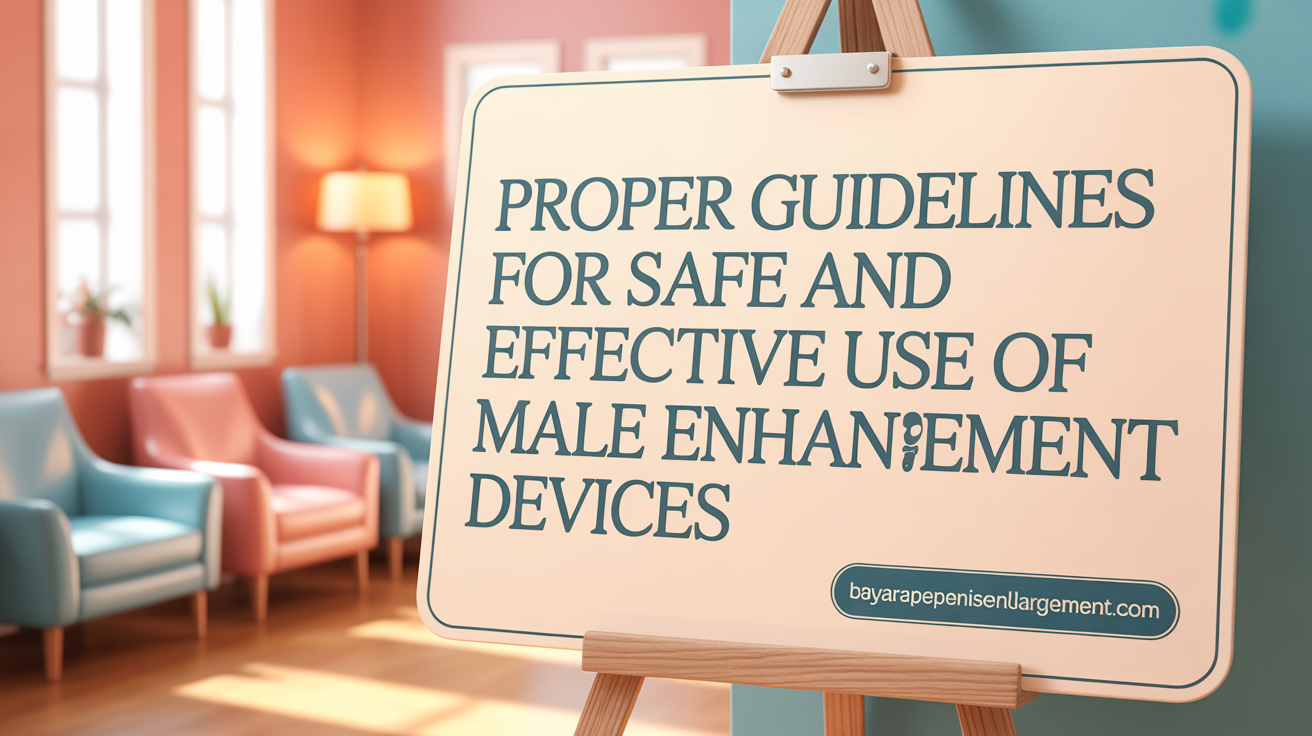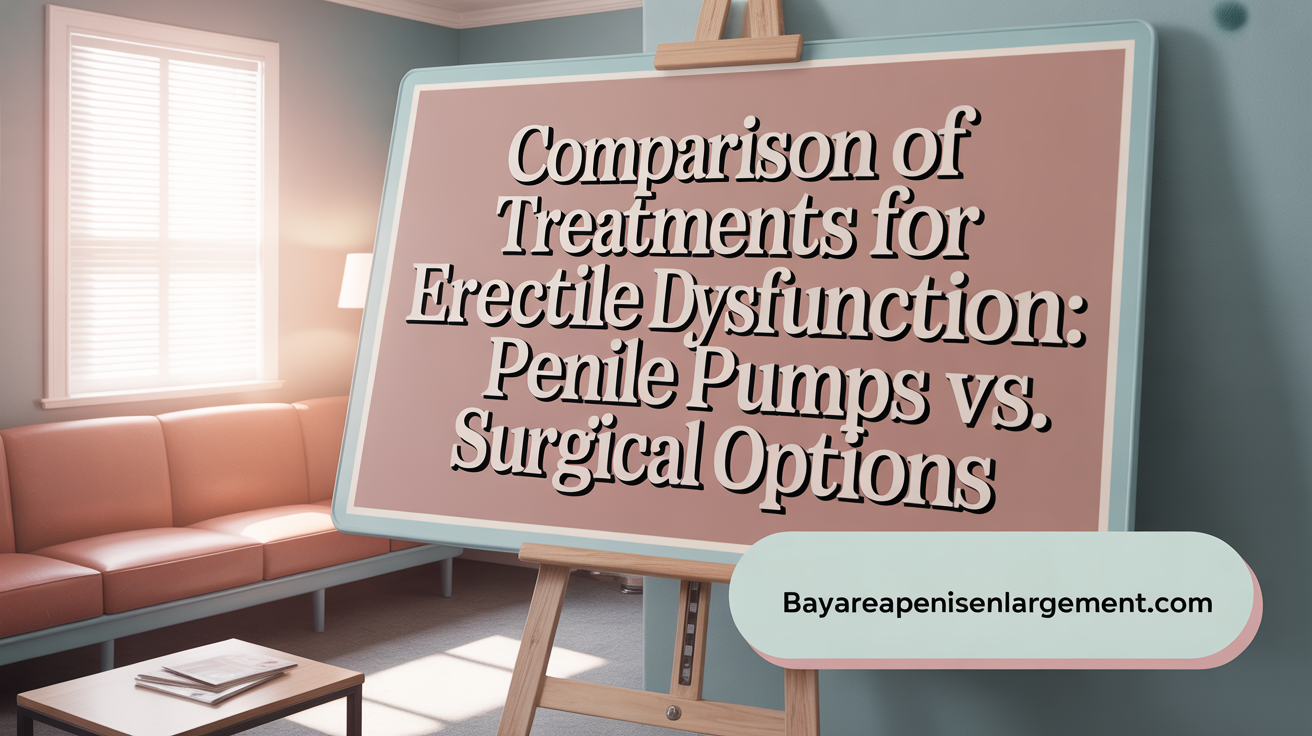Introduction to Penis Pumps and Their Role in Sexual Health
Erectile dysfunction (ED) is a common condition that can significantly impact quality of life. Among the various treatment options available, penis pumps—or vacuum erection devices (VEDs)—have emerged as a non-invasive, cost-effective alternative to surgery. This article examines the effectiveness of penis pumps as alternatives to surgical interventions, diving into how they work, their proper use, safety, benefits, limitations, and their role in treating conditions like Peyronie's disease. We will also compare these devices with surgical options to help men make informed decisions about their sexual health.
How Penis Pumps Work and Their Role in Erectile Dysfunction Treatment

How do penis pumps work and what is their role in erectile dysfunction treatment?
Penis pumps, officially known as vacuum erection devices (VEDs), are designed to help men achieve and sustain an erection through a simple mechanical process. The device consists of a plastic cylinder that fits over the penis, a pump that creates a vacuum, and often a constriction ring.
The operation begins with inserting the penis into the cylinder. The user then activates the pump—either manually or with a battery-powered motor—to evacuate air from within the cylinder, creating a negative pressure or vacuum around the penis. This vacuum encourages blood to rush into the corpora cavernosa, the spongy chambers inside the penis, leading it to swell and become erect.
Once an erection is achieved, a constriction or tension ring is slid from the cylinder onto the base of the penis. This ring helps trap the blood within the penile tissue, maintaining the erection for sex. Typically, the constriction ring should not remain in place longer than 30 minutes to prevent injury or tissue damage.
The vacuum effect and blood engorgement are the core mechanisms through which penis pumps help treat erectile dysfunction (ED). They serve as a safe, non-invasive alternative for men who cannot use medications or prefer a drug-free approach. When used correctly, penile pumps are highly effective — research suggests that they help about 90% of men with ED achieve a sufficient erection for sexual activity.
In addition to aiding hormone-related or psychological ED, penis pumps are useful in recovery post-prostate surgery or radiation therapy. They have been shown to improve blood flow, potentially restoring natural erectile function over time. As a non-drug, mechanical solution, they also pose fewer risks compared to surgical or injectable treatments.
In summary, by generating a vacuum that increases blood flow into the penis and using a constriction ring to maintain the erection, penis pumps play an important role in ED management. They provide a reliable, affordable, and effective option, especially suited for men seeking a noninvasive treatment method.
Proper Usage Instructions for Penis Pumps

What are the proper usage instructions for penis pumps?
Using a penis pump correctly ensures safety and optimal results. The first step is to apply a water-soluble lubricant to the penis and the rim of the cylinder to create an airtight seal. Next, insert the penis into the cylinder, making sure it's positioned comfortably.
Once the device is in place, operate the pump—either manually by squeezing the hand pump or automatically if battery-powered—to gradually remove air from the cylinder, creating a vacuum. This vacuum encourages blood flow into the penis, leading to an erection. When the desired firmness is achieved, quickly slide a constriction ring onto the base of the penis. This ring helps maintain the erection by constricting blood flow.
It is crucial not to leave the constriction ring on for more than 30 minutes to prevent tissue damage or other complications. After use, release the vacuum and carefully remove the device. Cleaning the pump as per the manufacturer’s instructions is vital to prevent infections. Always follow specific guidelines provided with your device and consult with your healthcare provider before starting use to ensure safety and effectiveness.
Lubrication and vacuum creation
Applying lubricant enhances comfort and helps achieve an effective seal between the device and your skin. When creating the vacuum, do so gradually to avoid injury. Excessive pressure can cause bruising, petechiae, or pain.
Using the constriction ring safely
The constriction ring is essential to maintain the erection by trapping blood within the penis. However, it must not stay on longer than 30 minutes to prevent damage or ischemia.
Duration and removal of device
Limit the use of the constriction ring to 30 minutes. To remove, first release the vacuum pressure (if your device has a release valve). Then, gently slide off the ring, and remove the device from around your penis. Proper care and cleaning of the equipment post-use help maintain safety.
Consultation and manufacturer guidelines
Always adhere to manufacturer instructions and seek medical advice if you have underlying health conditions like blood disorders or are taking blood thinners. Ensuring your device is FDA-approved or comes from a reputable source enhances safety.
Using a penis pump as directed can provide effective, on-demand erections, helping improve sexual confidence and function. Proper use minimizes risks and maximizes benefits, making it a valuable option for many men with erectile difficulties.
Effectiveness of Penis Pumps Compared to Surgery

How effective are penis pumps as an alternative to surgery for erectile dysfunction or penile enhancement?
Penis pumps, also known as vacuum erection devices (VEDs), are a widely used noninvasive treatment option for erectile dysfunction (ED). Research indicates that they are highly effective, helping men achieve a satisfactory erection in up to 90% of cases. They work by creating a vacuum inside a plastic tube that draws blood into the penis, resulting in an erection.
Most men using these devices report high satisfaction levels, with about 77% expressing contentment with the outcomes. The process involves placing the penis inside the tube, generating a vacuum with a manual or battery-powered pump, and applying a constriction ring at the base to maintain the erection for up to 30 minutes.
Compared to surgical approaches like penile implants, penis pumps are less invasive, more affordable, and come with fewer risks. Surgical options are typically reserved for cases where other treatments have failed and involve inserting devices into the penis, which are intended for permanent correction.
However, it's important to note that the benefits of penis pumps are temporary. The size increase or firmness achieved does not last permanently; the effects generally last around 30 minutes. They are often used as an adjunct to medications or other therapies, or as an initial treatment.
In summary, penis pumps serve as an effective, safe, and less invasive alternative to surgery for many men experiencing ED. They can restore ability to achieve an erection suitable for sex and can be used alongside other treatments to enhance overall outcomes.
| Comparison Aspect | Description | Additional Notes |
|---|---|---|
| Efficacy | Up to 90% success rate in achieving erections | Helps most men with ED |
| Satisfaction | Around 77% satisfaction among users | High satisfaction in studies |
| Invasiveness | Noninvasive | No surgery or injections needed |
| Cost | Generally low | Affordable with insurance coverage possible |
| Duration of effect | About 30 minutes | Temporary effect |
| Use with other treatments | Compatible | Can be combined with medications or implants |
| Risks and side effects | Mild, temporary | Bruising, petechiae, numbness |
| Penile enhancement | Not supported | No scientific evidence for size increase |
Search for more information using the query: "Penis pump efficacy versus penile implant surgery".
Safety Considerations and Risks Associated with Penis Pump Use
What are the safety considerations and risks associated with using penis pumps?
Using a penis pump can be a safe and effective way to treat erectile dysfunction when used properly. However, there are crucial safety aspects to consider to prevent potential injuries or complications.
A primary safety feature is the vacuum limiter, which controls the amount of negative pressure applied to avoid excessive force that could cause bruising, bleeding, or tissue damage. Over-inflation or applying too much vacuum can lead to petechiae (small red dots caused by burst blood vessels), pain, and skin discoloration.
The constriction band, often made of elastic material, should only be left in place for a maximum of 30 minutes. Longer use increases the risk of blood flow restriction, tissue injury, or permanent damage.
Proper device quality is essential. Men should look for FDA-approved pumps or devices from reputable manufacturers with safety features such as vacuum limiters and pressure gauges.
Applying a water-soluble lubricant helps ensure a good seal and reduces discomfort during use, whereas petroleum jelly can damage the device.
Men with certain health conditions need to exercise caution. Those with blood clotting disorders, taking blood thinners, or diagnosed with sickle cell anemia should consult a healthcare provider before using a pump, as they are at higher risk of bleeding or hematomas.
Serious side effects such as significant pain, extensive bruising, blood blisters, numbness, or a sensation of trapped semen require prompt medical attention.
Following manufacturer instructions carefully and consulting with a doctor can significantly reduce risks and ensure the device is used in a safe manner. Proper use involves inserting the penis into the cylinder, creating a gentle vacuum, attaching the tension ring at the base, and removing the device after the desired erection is achieved.
More info: Risks and safety tips for vacuum erection devices
This section emphasizes that while penis pumps are generally safe, responsible and informed use is essential to prevent injuries. Users should prioritize FDA-approved models, heed safety advice, and never use the device in a manner that causes pain or discomfort.
Benefits and Limitations of Penis Pump Therapy
What are the benefits and limitations of penis pump therapy?
Penis pump therapy, commonly using a vacuum erection device (VED), is recognized as a safe, non-invasive, and affordable treatment option for men experiencing erectile dysfunction (ED). The primary benefit of this approach is its ability to increase blood flow to the penis quickly, helping men achieve an erection suitable for sexual activity. Since it does not involve medication, injections, or surgery, it is generally well tolerated and can be used by men who cannot take or do not want to take oral ED drugs.
Another advantage is its compatibility with other ED treatments, such as oral medications, penile injections, or implants. Men recovering from prostate surgery or radiation therapy often find vacuum devices helpful in restoring or maintaining erectile function. Additionally, the devices are portable, easy to operate, and require minimal maintenance, making them accessible for most users.
However, there are limitations to penis pump therapy. The effects are temporary, typically lasting around 30 minutes, and do not lead to permanent size increases. Some men experience side effects such as bruising, petechiae (small red dots from broken blood vessels), numbness, coldness, or a bluish appearance of the penis. Discomfort or an unnatural feeling during erections can also occur, impacting spontaneity and overall satisfaction.
Psychologically, some users report feelings of awkwardness or embarrassment, and mechanical issues may arise if the device is not used properly. Furthermore, men with certain health conditions, such as blood clotting disorders or those on blood thinners, should consult healthcare professionals before use, as risks of bleeding and injury increase.
In summary, while penis pump therapy can be highly effective and a valuable part of a comprehensive ED management plan, it has its disadvantages. Proper technique, realistic expectations, and medical guidance are essential to maximize benefits and minimize risks.
Comparison of Penis Pumps to Surgical Options for ED and Penile Enhancement

How do penis pumps compare to surgical options for erectile dysfunction and penile enhancement?
Penis pumps, known scientifically as vacuum erection devices (VEDs), are considered a non-invasive, safe, and reversible method for treating erectile dysfunction (ED). They work by creating negative pressure around the penis, drawing blood into the penile tissue to induce a temporary erection. This approach is often used as a first-line treatment or alongside medications, especially after prostate surgeries.
In contrast, surgical options such as penile implants involve inserting prosthetic devices into the penis and can provide a more permanent solution to ED. These surgeries carry higher risks, including infection, bleeding, and mechanical failure, and generally require longer recovery periods.
The effectiveness of pumps is notable, with research indicating they successfully produce sufficient erections in approximately 80-90% of cases. However, their results are temporary, lasting around 30 minutes, and they do not physically alter penis size over the long term. Conversely, surgery can offer a lasting increase in erectile function or penile size, but not without potential complications and longer recovery time.
For men recovering from prostate surgery, penis pumps can be particularly beneficial. They aid in penile rehabilitation by promoting blood flow, helping prevent penis shrinkage, and restoring natural erectile function.
When choosing between these options, patient considerations such as overall health, severity of ED, personal preference, and treatment goals are crucial. While pumps are less invasive, reversible, and carry fewer risks, surgery might be indicated for severe cases or when other treatments have failed.
In summary, penis pumps provide a safe, temporary, and adjustable method for managing ED with minimal recovery time, whereas surgical procedures offer a more permanent but invasive solution, with a higher risk profile. Consulting with a healthcare provider can help determine the most appropriate treatment based on individual medical conditions and preferences.
Penis Pumps and Peyronie's Disease: Effectiveness and Considerations
Are penis pumps effective for Peyronie's disease and other specific erectile issues?
Vacuum erection devices (VEDs), commonly known as penis pumps, have shown promise in treating Peyronie's disease—a condition characterized by the development of fibrous plaques causing penile curvature. Studies indicate that when used appropriately, VED therapy can significantly improve this curvature, with an average reduction of about 23 degrees. These devices work by increasing blood flow to the penis, which can help straighten the penis and reduce discomfort.
Beyond Peyronie's, VEDs can enhance erectile function for various causes of ED, including post-surgical recovery and other vascular issues. They are especially beneficial for individuals who cannot tolerate medications or prefer non-invasive options. Patients have reported reductions in plaque size and improved erections, contributing to higher satisfaction levels.
Clinical study outcomes
Research involving VED therapy for Peyronie’s disease typically demonstrates positive results. In one study, 31 men with the condition used a vacuum device twice daily over a 12-week period. Results showed notable improvements: around half of the participants experienced a decrease in curvature by 5-25 degrees, and many reported less pain and better penile length.
These findings support the use of VEDs as an effective, non-invasive treatment to reduce deformity and improve sexual function. Many users also report increased confidence and avoidance of more invasive procedures like surgery.
Safety and risk of tissue damage
While generally safe, improper or excessive use of penis pumps carries potential risks. Overinflation or applying too much force during pumping can cause tissue damage, including bruising, petechiae (red spots from burst blood vessels), or even worsening the curvature in Peyronie's cases. Extending use of constriction rings beyond 30 minutes, or using inappropriate devices, may lead to tissue strangulation or permanent damage.
It’s critical to follow medical guidance, ensuring devices are used within safe parameters. Modern FDA-approved devices incorporate safety features like vacuum limiters to reduce injury, making proper use essential for safety.
Use in combination with other therapies
VEDs often serve as part of a comprehensive treatment approach. They can be combined with medication, like oral PDE5 inhibitors, or used alongside penile injections. Some men find that combining therapies offers better outcomes, particularly in complex cases or post-surgical rehabilitation. For Peyronie's, using a pump may help improve penile flexibility and facilitate other treatments like injections or medications.
Patient satisfaction and surgical avoidance
Most users report high satisfaction with vacuum therapy; studies show approximately 77% of men and their partners are pleased with the results. The non-invasive nature, low cost, and safety profile make VEDs an attractive alternative to surgery. For many patients, initial use can reduce the need for more invasive options, such as penile implants or surgical correction.
Overall, penis pumps are valuable tools in managing certain erectile and penile deformity issues. When used correctly under medical supervision, they can offer meaningful improvement and a non-invasive path to restoring sexual confidence.
Scientific Evidence on Permanent Penile Size Changes from Pumps
When considering the use of penis pumps, many men wonder if these devices can lead to permanent increases in penis size or girth. Currently, scientific research does not support the idea that vacuum pumps produce lasting changes in penile dimensions.
Most studies focus on the effectiveness of vacuum devices for achieving temporary erections and improving sexual confidence. For instance, research from 2003 to 2004 observed that prolonged use of vacuum therapy led to slight, approximately 10% increases in penile length. However, these results were not statistically significant and did not translate into meaningful or permanent size gains.
The primary benefits of vacuum pumps are related to psychological satisfaction, improved erectile function, and sometimes aiding in the treatment of conditions like Peyronie’s disease or penile rehabilitation post-surgery. They help optimize blood flow and can restore some natural erectile capabilities without causing damage.
It is important to address common myths: claims that these devices can enlarge the penis permanently are unfounded. The device’s effects last only for the duration of use—generally about 30 minutes—and any size increase is temporary.
In specific medical contexts, such as before penile prosthesis surgery, vacuum therapy can assist in maintaining penile length during recovery. Nonetheless, this does not equate to permanent enlargement. Overall, the consensus in research is clear: vacuum pumps are effective tools for enhancing erectile function, but they do not produce lasting size increases.
For reliable information, you can search for studies using keywords like "research on vacuum therapy and penile size permanence." Consulting healthcare providers can also clarify expectations regarding what vacuum devices can and cannot do.
Overall Viability of Penis Pumps as Non-Invasive Treatment Alternatives
 Penis pumps are a practical non-invasive option for men dealing with erectile dysfunction (ED). They work by creating a vacuum around the penis, which draws blood into the tissue, thus producing an erection suitable for sexual activity. Their effectiveness is notable across various causes of ED, such as post-prostate surgery, circulatory problems, or psychological factors.
Penis pumps are a practical non-invasive option for men dealing with erectile dysfunction (ED). They work by creating a vacuum around the penis, which draws blood into the tissue, thus producing an erection suitable for sexual activity. Their effectiveness is notable across various causes of ED, such as post-prostate surgery, circulatory problems, or psychological factors.
Compared to surgical options or injections, penis pumps have a favorable safety profile. When used correctly, they pose fewer risks — common side effects like petechiae, mild discomfort, or discoloration are usually temporary. Proper use, including moderation of the constriction ring and following safety guidelines, minimizes injury risk.
Cost is another advantage. These devices are generally affordable, often a one-time purchase, and usually covered by insurance as a recognized ED treatment. They are accessible over the counter or through prescriptions, making them readily available for many men.
Penis pumps can be combined effectively with other treatments such as oral ED medications or penile implants. They are especially useful in penile rehabilitation after prostate procedures, helping to restore and maintain erectile function.
Before starting use, consulting with a healthcare provider is advisable, particularly for men with blood disorders or those on blood-thinning medications. Professional guidance helps ensure the selected device is appropriate, safe, and used properly.
In conclusion, penis pumps are a safe, affordable, and versatile non-invasive treatment for ED, offering a reliable solution for many men. Their ability to deliver on-demand erections with minimal risks makes them an appealing option for those seeking alternatives or supplements to other therapies.
Conclusion: Assessing Penis Pumps as Alternatives to Surgical Treatment
Penis pumps or vacuum erection devices emerge as effective, safe, and non-invasive tools in managing erectile dysfunction and related penile conditions. They offer a distinct advantage by providing a reversible, low-risk alternative to surgery, suitable for many men who either cannot or prefer not to undergo invasive procedures. While they do not cure ED or permanently increase penis size, their ability to facilitate strong, sustainable erections and improve quality of life has been validated by clinical studies and user satisfaction reports. With proper usage, medical guidance, and understanding of limitations, penis pumps can serve as a valuable part of a comprehensive ED treatment plan, bridging the gap between pharmacological and surgical therapies.
References
- Penis pump - Mayo Clinic
- Penis Pumps: How They Work and What to Expect - Healthline
- What Are Penis Pumps? Are Penis Pumps Safe for Treating ED?
- How to use a penis pump: Effects and safety - Medical News Today
- Penis Pump - Comprehensive Urology
- Penis Pumps: What They Are and How to Use Them - WebMD
- Penis Pump Therapy for Erectile Dysfunction - Tower Urology
- Erectile Dysfunction Pump vs Penile Implant - Happy Urology

